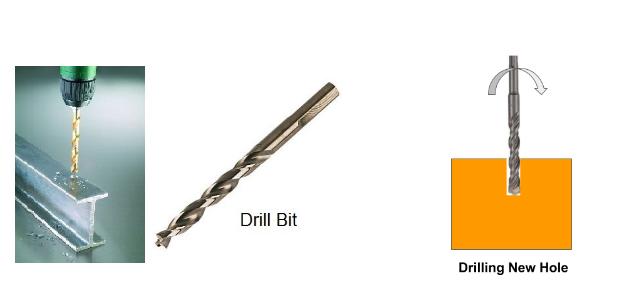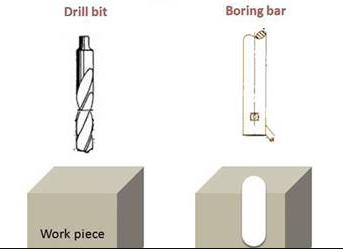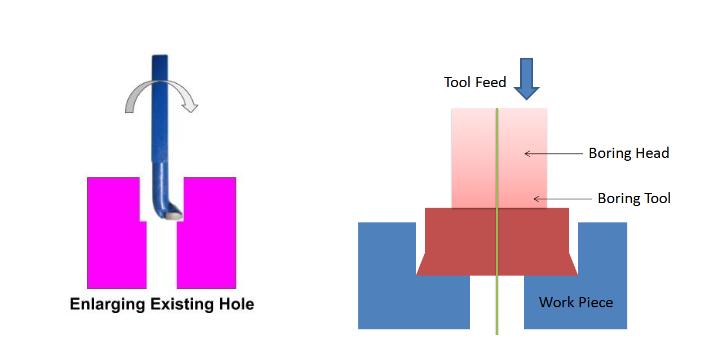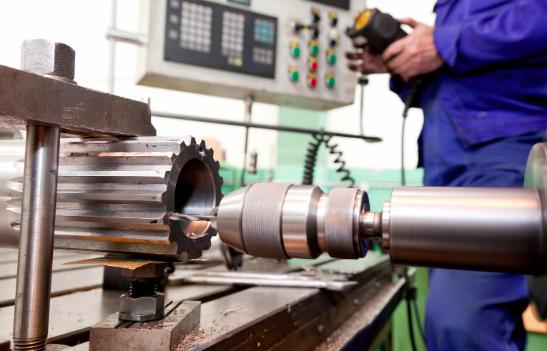If you've ever wondered how holes are made in objects like metal, wood, or plastic, you're about to uncover the secrets of two fascinating processes: drilling and boring. These techniques are used in various industries to create holes of different shapes and sizes, but they have distinct differences and purposes. Let's dive into drilling and boring to understand what sets them apart and when each method should be used.

Imagine you need to make a hole in a piece of metal or wood. The drilling process is your go-to solution. It's like using a powerful spinning tool to create a hole where you want it. The magic happens with a CNC drilling machine that uses a special spinning tool called a drill bit.
The drill bit looks like a twisty rod with sharp edges. As it spins fast, it bites into the material and creates tiny pieces called chips. These chips are pushed out of the way by grooves on the drill bit's surface, letting the hole get deeper and deeper. This spinning, cutting, and chip-making combination helps us create holes.

Not all holes are the same, and that's where different types of drilling come into play:
• Twist Drilling: This is the most common type. It uses a drill bit with twisty edges that cut into the material while it spins. It's good for making holes that aren't too deep or super precise.
• Gun Drilling: Imagine a very skinny and long drill bit. That's what gun drilling uses. It's perfect for making straight and long holes, especially tiny ones.
• Centre Drilling: A little divot is created in the center before some holes are made. It's like making a small mark to guide the drill. This is done using a special tool called a center drill bit.
You'd be surprised how many things around us have holes made by drilling. Drilling is a big deal, from the shiny parts in cars to the tiny pieces in your smartphone. Industries like cars, medicine, airplanes, electronics, and buildings all rely on drilling to make holes for various parts.
Drilling, often likened to a superhero in hole-making, boasts remarkable strengths and a few chinks in its armor. Let's delve into the advantages and disadvantages of this powerful technique:

• Speed and Efficiency: When the need for many holes arises, drilling takes the lead. Its swift and efficient nature saves time and energy, making it the go-to option for high-volume hole creation.
• Precision Perfection: Modern CNC drilling machines exhibit near-magical accuracy. They pinpoint hole locations with remarkable consistency, ensuring each hole is precisely where intended, a feat few other techniques can match.
• Versatile Drill Bits: With an array of drill bits at its disposal, drilling adapts effortlessly to various hole requirements. From micro-sized openings to larger cavities, there's a drill bit designed to match the task, making it incredibly versatile.
• Cost-Effective Solution: In hole-making, drilling is a cost-effective choice. Its ability to deliver accurate and swift hole creation makes it a valuable investment, offering substantial returns for its relatively modest costs.
• Imperfect Finishes: Despite its heroic efforts, drilling isn't always the smooth operator it aims to be. The finish of drilled holes might fall short of flawless, occasionally leaving rough or uneven edges.
• Wear and Tear: Every hero has a finite lifespan, and for drilling, it's the drill bit that faces wear and tear. Extended use can gradually decline effectiveness, demanding regular bit replacement to maintain optimal performance.
• Size Limitations: Although versatile, drilling has limitations in terms of hole sizes. While it excels at producing small and moderately sized holes, it struggles to accommodate large or minuscule openings.

Imagine you already have a hole, but it's not the right size or shape. Or maybe it needs to be extra precise. That's where boring comes in. Boring is like the artist who takes an existing piece of work and refines it to perfection.
Let's say you have a special machine with a cutting tool attached. This cutting tool is called a boring bar, a bit like a drill bit but more sophisticated. As the boring bar spins, it carefully removes bits of material from the hole, making it just how you want it.

Boring comes in different flavors, too:
• Horizontal Boring: When the hole needs to be straight and parallel to the surface, like for big, heavy objects, horizontal boring is the choice.
• Line Boring: This is for long, straight holes, like you'd find in engines.
• Jig Boring: When you need holes to be extra precise, like making tools or airplane parts, jig boring is your best friend.
Boring might not be as famous as drilling, but it's crucial for creating perfect holes. Boring helps fine-tune holes to fit like a glove, from engines to medical devices to airplane parts.
Boring might not be the most exciting topic, but when it comes to hole-making, it's like having a master chef in your toolkit. Just like even the finest chefs face challenges in the kitchen, CNC boring machines also come with advantages and disadvantages worth exploring.
• Precision Hole-Making: Boring machines are the true artists of the engineering world, exhibiting laser-like precision in creating holes. They can carve out holes exactly as needed, adhering to stringent specifications. This precision is crucial in various industries, from manufacturing to construction, ensuring components fit together seamlessly.
• Versatility in Hole Shapes and Sizes: One of the major perks of boring is its ability to create holes in a wide range of shapes and sizes. Whether you need a simple round hole or a more intricate form, a CNC boring machine can accommodate your requirements. This versatility makes them indispensable in crafting diverse products and structures.
• Efficiency in Hole-Improvement: Boring proves its worth in hole-improvement tasks. It can quickly and accurately resize or refine existing holes, allowing for adjustments without requiring complete replacements. This efficiency not only saves time but also minimizes material wastage.
• Inaccessible Tricky Spots: While CNC boring machines are adept at their craft, they have limitations in accessing tight or hard-to-reach spaces. Their size and design might restrict their use in certain scenarios, making creating holes in confined or intricate areas challenging.
• Material Compatibility: Not all materials are created equal, and some may pose difficulties for boring. Exceptionally hard or brittle materials might resist the boring process, leading to potential tool wear, breakage, or imperfect hole formation. In such cases, alternative hole-making methods might be more suitable.

Drilling and boring are two distinct hole-making processes, each with its characteristics and applications. Let's explore the differences between drilling and boring in detail:
• Drilling: Drilling is primarily employed to create new holes in a work piece. It serves as the starting point for hole-making operations. Think of it as piercing through material to make a hole from scratch. This is often used when a new component or structure requires holes, such as in construction or woodworking.
• Boring: Boring, conversely, is all about refining and enhancing existing holes. It assumes there's already a hole in the material, and its purpose is to make that hole more precise or enlarge it. Boring is akin to the fine-tuning of holes that have already been created. This precision is crucial in industries requiring tight tolerances and exact measurements, such as aerospace engineering or medical device manufacturing.
• Drilling: In drilling, the workhorse tool is the twist drill bit. These bits have sharp edges that cut into the material as they rotate. They are designed for initial hole creation and are generally straightforward.
• Boring: Boring employs specialized cutting tools called boring bars. These bars are equipped with single-point cutting edges designed for precision work. Unlike drill bits, they are more complex and specifically designed to refine and enlarge existing holes with utmost accuracy.
• Drilling: Drilling is generally less precise compared to boring. It's suitable for applications where extreme precision isn't the top priority. This makes it an excellent choice for tasks where the hole's exact measurements aren't as critical.
• Boring: Boring is renowned for its high precision. It excels when tight tolerances and exact measurements are crucial. If you need a hole that has to fit a specific component perfectly, boring is the way to go.
• Drilling: Drilling is versatile and can create various hole shapes, including cylindrical and non-cylindrical ones. This versatility is useful when different hole shapes are required in a project.
• Boring: Boring is ideal for refining and enlarging holes, improving precision, and achieving smoother internal surfaces. It is specifically geared towards making existing holes more precise and uniform.
• Drilling: Drilling operations are typically faster than boring. This makes it advantageous for high-volume production where speed is of the essence. Industries that require many holes in a short time, like construction, often rely on drilling.
• Boring: Boring operations might take more time due to their focus on precision. It's suitable for applications where accuracy matters more than speed. Industries prioritizing quality over quantity, such as aerospace engineering, often favor boring.
• Drilling: Holes drilled with traditional twist bits may have a less polished surface finish. This is acceptable in many applications where aesthetics and surface smoothness aren't critical.
• Boring: Boring produces smoother and higher-quality hole walls, resulting in a superior surface finish. This is crucial in industries where aesthetics and precision are paramount, like medical devices or high-end automotive components.
• Drilling: Drilling is widely used in industries that require high-volume hole creation, where extreme precision isn't the primary concern. Examples include construction, where holes are needed for bolts, screws, or pipes.
• Boring: Boring is indispensable for applications demanding precision, accuracy, and smooth hole walls. Industries like aerospace, automotive (for engine cylinders), and medicine (for surgical implants) benefit from the refined boring results.
• Drilling: Drilling and boring can both work on various materials. However, drilling might be more suitable for softer materials with less critical precision.
• Boring: Boring is preferred for harder or more brittle materials due to its controlled cutting and precision capabilities. It can be the go-to choice for machining tough materials like aerospace alloys.
• Drilling: Drilling is generally more cost-effective than boring, mainly due to its faster operation and simpler equipment requirements. It's an efficient choice for industries where speed and budget are important factors.
• Boring: Boring operations can be costlier due to the intricacies of boring bars and the potential need for more frequent maintenance. However, its precision and quality can often justify the higher cost in industries where precision is paramount.
• Drilling: Drilling can be performed by operators with varying skill levels, making it accessible to a broader range of individuals. Basic training is often sufficient for proficient drilling.
• Boring: Boring requires more specialized training and skill due to its precision requirements and the intricacies of the process. Skilled operators are essential to achieve the desired results, making it a more specialized field.
• Drilling: While the frequency might be lower than boring operations, drilling bits require maintenance. Regular sharpening and replacement may be needed to maintain performance.
• Boring: Boring bars, being more complex, might need frequent maintenance and careful handling to ensure longevity and consistent performance. This maintenance requirement is a trade-off for the high precision and surface finish it offers.
Understanding these differences is essential for making informed decisions when selecting between drilling and boring methods for hole-making processes.

When you're faced with the choice between drilling and boring, remember these things:
• How precise does the hole need to be?
• What kind of finish do you want inside the hole?
• Is the material too hard or too brittle?
• How big is the hole you need?
• How many holes do you need to make?
In the world of hole-making, drilling and boring are the dynamic duo. Drilling is like the pioneer, making new holes in a flash. Boring is the perfectionist, refining holes to perfection. Whether it's a simple hole in a wall or a critical part in an airplane, these techniques keep our world full of perfectly shaped spaces. So, the next time you see a hole, remember the powerful processes that created it!